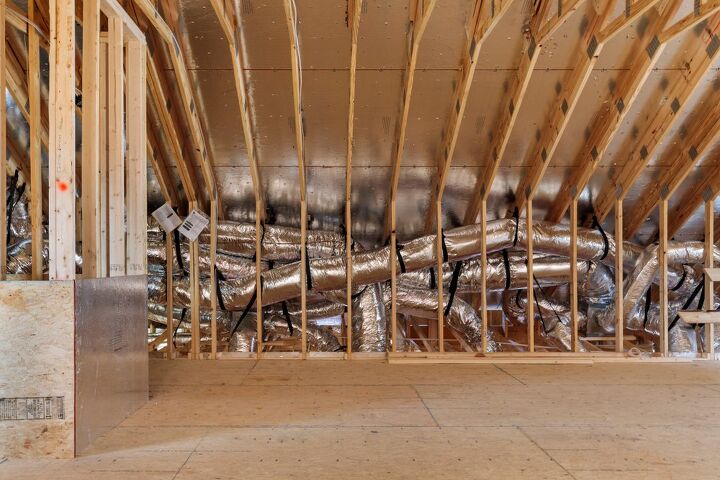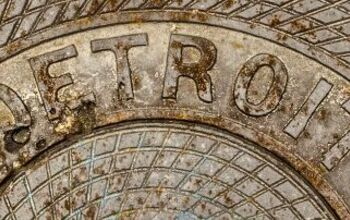What Are The Pros And Cons of a Furnace In The Attic?

It wasn’t until I owned my own home that I realized how coveted storage space is. Having an entire closet dedicated to a furnace seems like a giant waste of storage space. So, what about the attic? Could that be a practical place to install a furnace to save storage space on living floors?
Because the access point is through the roof, installing a furnace in the attic is cheaper and easier. The venting system can be installed directly through the roof. When a furnace is in an attic, there’s a tendency for lower levels of energy efficiency. Problems can go undetected for a while because the area is not frequented by homeowners.
Space Saver
A furnace closet takes up so much space that could be used for a million other things. There are plenty of things you need more frequent access to other than your furnace. Maybe that’s why you’re here reading this article.
Pro: Putting the furnace in the attic creates more useable space because it lives in an area you don’t normally use. This, in turn, allows for more storage space in the main living areas.
Aside from putting it in the attic, there are other unique ways to hide your furnace.
Out of Sight Out of Mind
I don’t know about you, but if something isn’t directly in front of my face, I usually forget about it. This can happen when a furnace is housed in the attic.
Con: Problems can go undetected for a while because the area is not frequented by homeowners. There’s a higher chance of forgetting to change filters because it’s not within view. A clogged condensate drain may not be noticed until moisture overflow appears somewhere else in the home. This may lead to mold in the floor joists or insulation, ceiling leaks, and potential damage to fixtures.
On top of that, certain types of furnaces can’t be installed in an attic. Condensing furnaces can’t be placed in spaces without climate control. As they heat the air, they produce water that can freeze when exposed to very cold temperatures. This will ultimately damage the unit.
Placing a furnace in the attic creates a higher risk for damage to both the unit and the house unless the attic is finished. However, making an attic a livable space can come at a great expense.
Cheap and Easy Installation
Sometimes placing a furnace in the attic is the only thing that is cost-effective. It requires less work to install venting for a furnace in the attic.
When a house is built on a slab and the furnace is on the lowest level, the venting equipment usually goes through the garage. This is how my house is designed. When the furnace is in the attic, the venting goes directly through the roof rather than being installed in an exterior wall which is costly. Instead, the ductwork can be installed along the upper floor.
For a mid-efficiency furnace, the price of a downflow and upflow furnace is equivalent. Equipment is around $1,000 and installation is another $1,000. The price can double depending on the difficulty of installation or for a product with a higher level of efficiency.
Pro: It’s cheaper to install a furnace in the attic because the access point is through the roof rather than an exterior wall. Because the ductwork is visible along the attic floor, it’s also cheaper to replace and repair the unit.
Due to the ease of installing in the attic, you can focus on putting your money toward a model that will work for your home. There’s no need to worry about how costly it will be for a difficult install.
Low Energy Efficiency
Heat rises naturally, so the coldest air is on the lowest level of a house. The furnace creates a cycle where it takes the coldest air, heats it, and blows it out through the rest of the house. Installing a furnace in the attic means this cycle won’t occur naturally. Infrastructure is needed to achieve it.
This equates to higher energy costs and less efficiency because air is forced down instead of being allowed to rise naturally.
Con: When installing a furnace in the attic, there’s a tendency to lose energy efficiency. This loss can be as much as 35%. In addition to that, the hot air is already at its highest level. So, the furnace has to run longer to heat colder areas of the house, raising your energy bill.
Even in perfect conditions, you still tend to lose roughly 30% of the air moving through the ducts. This is due to cracks, holes, and poor venting connections. Coupled with a frequently running furnace, this scenario is not energy efficient.
Ergonomic Design
A furnace is a forced-air system, which is the most popular type of HVAC system installed in homes. Some furnaces are built with a downflow design. In a downflow furnace, cool air is pulled downward to the combustion chamber where it’s heated.
Pro: This type of furnace works best when placed in the attic. The airflow is taken advantage of, and this furnace will work in all types of homes.
Check out this guide on the pros and cons of hydro air heating.
Uncomfortable Heat
The heat produced from a furnace in an attic may not always feel comfortable. It’s hitting your head first rather than your feet, which some people claim feels like a warm fan. If you’re not used to it, the sensation can feel disconcerting.
Con: It’s possible the heat may never hit your feet, especially in very cold temperatures. This is because the heat starts rising as soon as it’s released through the vent. If your vents are not along the floor, the heat won’t reach your feet.
Safety Options
Even though there’s a tendency for problems to go unnoticed, that’s not to say a furnace in the attic is unsafe. Any type of equipment can be installed safely—even a gas furnace.
Pro: There are furnace systems available with alarms that quickly detect leaks. This safety measure plus proper venting can ensure the safety of a gas furnace in the attic.
Pro: Choosing a gas furnace over an electric one ensures higher energy efficiency. You can also finish the attic to avoid efficiency loss or create a small furnace room in the attic to solve this problem. So, while it’s still not the most energy-efficient choice to have a furnace in the attic, there are ways to make it more energy-efficient.
Strict Installation Regulations
Usually, there are stricter regulations for installing a furnace in an attic, though it does depend on your location. Some regulations state that nothing combustible can be around the unit except wood joists that support it.
Con: In order to keep to code, people often find they must purchase a separate sub-base as a barrier between the furnace and the floor.
Older Furnace Models
Having a furnace in an attic is an older design model which could mean your equipment needs to be updated. People used to be more concerned with space than utility bills.
Con: If your home has this design already or you’re thinking of purchasing one like this, check the age of the equipment. Replacing it could cost anywhere between $1,795 and $6,290, depending on many factors.
Related Questions
We’ve covered a lot of pros and cons of putting a furnace in the attic. But maybe you have more questions. Below are some things other people wondered about installing a furnace in the attic.
How long does an attic furnace last?Most furnaces are built to last between 15 and 30 years. Most experts recommend you start looking for a replacement at the 15-year mark. You can ensure the upkeep of your unit by scheduling regular maintenance checks with a reputable HVAC company.
What causes an attic fire?One of the ways a fire can happen in your attic is if you have a furnace up there. Attics are notoriously hot in the summertime. In excessive heat, it’s possible for your attic furnace to overheat and catch on fire.
How do I vent my attic?Properly venting your attic is important when it’s the location of your furnace. To improve ventilation in your attic, you can take the following steps:
- Insert roof vents
- Add vents to the soffits
- Install gable vents
- Improve the airflow by using fans
Summing It Up
Although placing a furnace in the attic is an older home design, it still has some advantages. For one thing, you’ll have more storage space on the main living levels of your house. It’s also easier to install and fix an HVAC system when it’s in an attic rather than hidden inside the walls.
Unfortunately, the cons definitely outweigh the pros on this one. The disadvantages of having a furnace in the attic can end up being devastating. You might not know there’s something wrong with the unit until it becomes a major problem. At that point, there might be damage that extends beyond the unit itself.
Perhaps the biggest con of a furnace in the attic is the loss of energy efficiency.

Brigid Levi is a wife, mother, and freelance writer who enjoys a good DIY project and creating beautiful spaces within her home. From cleaning and organization hacks to home decor ideas, she loves helping people in their quest to turn a house into a home. Her hobbies include pretending to be Joanna Gaines while updating her home with her husband and performing in local theater productions.
More by Brigid Levi



























